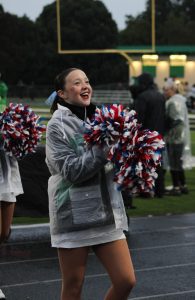Page 1: Ao Dai — More than meets the eye
September 29, 2021
Shang-Chi, the first Chinese superhero in the Marvel Cinematic Universe. Devi, the Desi teenage lead in the Netflix series “Never Have I Ever.”
This year bears witness to a rise in Asian cultural representation that began with “Crazy Rich Asians” in 2018.
“I feel like when “Crazy Rich Asians” came out, there was a boom for the Asian-American community because we had never seen a production on that level before and with that amount of representation,” junior Thu Le said.
But one specific cultural symbol has increasingly emerged: áo dài, a traditional Vietnamese garment, which is pronounced ow yai.
Worn by both men and women, áo dài consists of a fitted top that flows over loose-fitting trousers and reaches the knees for men and the heels of the feet for women.
“I only wear my áo dài at important events in Vietnamese culture,” junior Andy Nguyen said. “Like, most recently, I wore my áo dài at my sister’s wedding.”
For Kelly Marie Tran, the voice actress of Disney’s Raya, she paid homage to her heritage and donned a black áo dài with gold embroidery at the premiere of “Raya and the Last Dragon” in May of this year.
People oohed and ahhed over the intricacies of the dress — the silk thread, the train of fabric that trailed behind, the sparkling whorls of gold.
But while the design of áo dài can be a sight to behold, the heart of its significance lies with a timeless spirit that bridges internal divides, unifying the varied aspects of cultural identity.
“It makes me feel in tune with myself and the (Vietnamese) part of me,” Le said. “Especially after moving here and growing up in the U.S., sometimes you feel lost and you don’t really know: Am I Asian? Am I American? Am I both?
“So when I wear traditional clothing like áo dài, it just makes me feel more connected to who I am.”
Mainly worn on Tết, the Vietnamese Lunar New Year, or at weddings, áo dài — all within this year — has emerged into the public eye, appearing at a swearing-in ceremony, a red carpet and a fashion showcase.
Bee Nguyen, Georgia’s first Vietnamese-American state representative, wore a blue áo dài when she was sworn into her second term in January.
Kelly Marie Tran proudly posed with her áo dài at the premiere of “Raya and the Last Dragon” in May.
Amanda Nguyen donned a white áo dài in a September fashion showcase for sexual assault survivors. Covered in text from the Survivors’ Bill of Rights, she also commemorated her own proposed legislation that became one of 22 bills in U.S. history to pass unanimously through Congress.
Public figure or not, áo dài is a treasured garment.
“When other people see (me wearing my áo dài), they can recognize that I’m just trying to express my own culture in a place where it’s not commonly expressed,” Andy Nguyen said.
From celebrating Lunar New Year and taking an oath of office to commemorating landmark legislation, áo dài continues to sustain its unique vitality as a symbol of heritage and tradition in an ever-evolving world.






